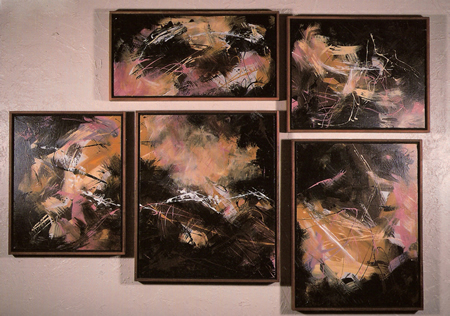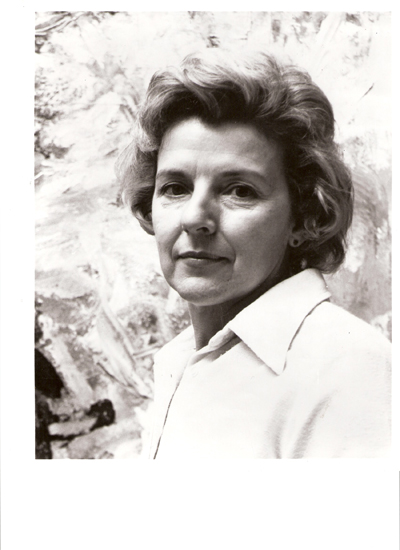 |
InsideAbstract ArtLectureby Verna Brady
Audio files of one of Verna's Lectures similar to the written lecture below can be found here. It is in four parts, total length about an hour. I suggest listening to the tapes while reading along with the lecture. They are not exactly the same, but very close.
|
As you are undoubtedly well aware, contemporary artists are working in many, many different ways today with no one “school” being the only method. This catholicity is very exciting and rewarding for the artists, but all too frequently extremely baffling to their audience, and so I would like to discuss the working methods of artists subscribing to the concepts and theories of one of the greatest teachers of the 20 th Century, Hans Hofmann.
Hans Hofmann
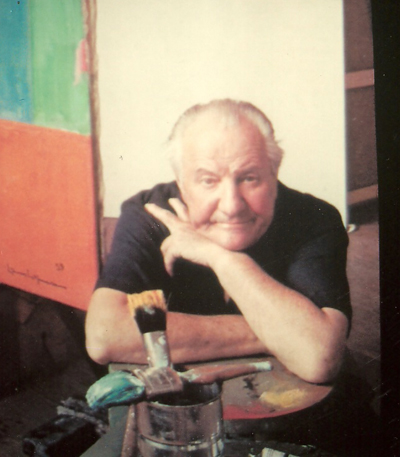 |
Hans Hofmann has often been called the Father of American abstract painting, for he devoted his life primarily to teaching, and painting secondarily. He taught a total of 43 years—mostly in schools in Munich , New York and Provincetown . As you can well imagine, this long period enabled him to influence hundreds of students from a period of several generations, many of whom have also gone on to become great teachers: Nevelson, Frankenthaler, Rivers and McNeil, to name just a few. Hoffmann retired in 1958 at 78 to devote the remainder of his life exclusively to painting. He died in 1966.
My own experience with Hofmann
My own experience with Hofmann began by seeing pictures of his works in art books, then reading his own book, Search For The Real, and finally seeing an actual painting. I was living outside Milwaukee at the time, and there was an exhibition in town from a New York collection. Living in the Middle West didn't afford much opportunity to see what was going on in New York except in Art magazines; so, I hurried down to see the show. As I wandered through, suddenly and unexpectedly, I came face-to-face with my first “Real” Hofmann—“The Pond.” (1958)
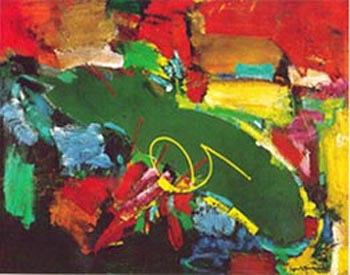
The Pond, Hans Hofmann 1958
I was so excited I hardly saw the rest of the show. I hurried through, rushed to my car, drove straight home and went straight to my easel. I then painted for 5 hours steady, trying to put down all I felt as a result of that experience. My response was partly due to how much more vibrant and alive the actual painting was compared to reproductions, and partly because right there before me seemed some of the solutions to the problems I had been working on in my own paintings. This painting is the result of that day.
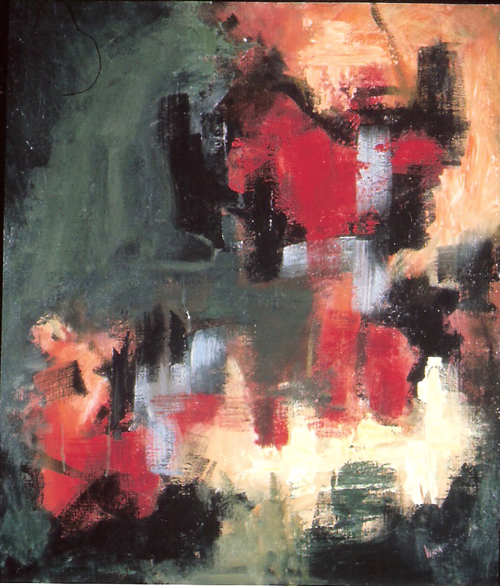
Through the Trees 1968
It's different from Hofmann's, of course, because I'm different, but it's working the same problems and concepts.
My ultimate understanding of Hofmann's more difficult theories, like push/pull and dynamic equilibrium, occurred in Paris under the tutelage of Dr. George McNeil.
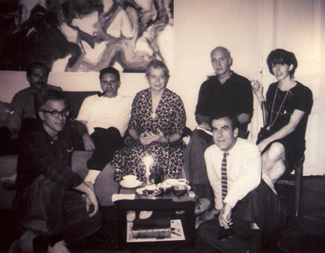 |
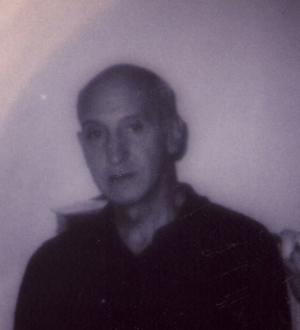 |
I chose to go to Paris because the program was being run by Antioch College , which I knew to be very avant-garde, and I felt the influence would be good for me. But never in my wildest dreams could I have imagined I'd be lucky enough to have George McNeil for my painting teacher! McNeil is Hofmann's principle protégé and disciple and has, himself, been teaching a total of 27 years [at the time of these lecture notes, approximately early 70's]—mainly at Pratt in New York and occasionally in Paris.
George McNeil and Hofmann's Concepts
It was his personal interpretation of Hofmann's concepts that finally opened the doors for me to the new world of contemporary expressionism---because I was ready for him and open to his way of thinking. I had been studying “Search For the Real” [book by Hofmann] for a long time and was most anxious to fully comprehend Hofmann's more difficult theories.
[For a deeper view of Verna's transition in Paris under McNeil's tutelage, please refer to her book page and excerpts. It can also be found on this site here.]
And since you are [reading this today], I assume you, too, have a desire to better understand why contemporary artists work as they do. To help along that line... first we will start with the two influences on an artist---nature and his medium of expression—and discuss how they mold his ideas. Then we will move on to how the artist uses his medium and his faculty of empathy to transform the blobs of paint into a spiritual experience we call “Art.”
Nature and the artist's medium of expression
Hofmann said that Nature is the source of all inspiration—whether you work directly from it, from memory or from pure fantasy. The first reaction to that statement in most people's minds, however, is landscape in the traditional sense: rocks, trees, and buildings. But Hofmann was referring to Nature in a much broader sense. Consider for a moment the many abstract forms in nature—
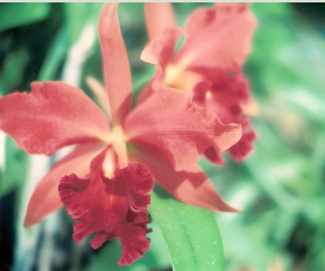 |
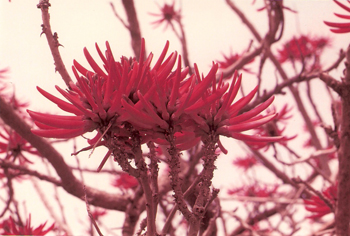 |
the shapes of flower petals....,our own California sand dunes with their ever-changing patterns of wind and shadow and rock forms.
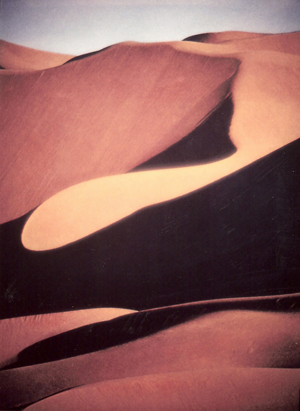 |
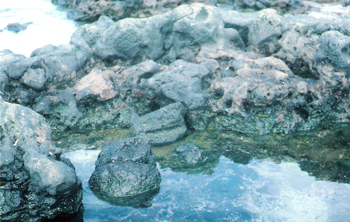 |
Now let us go on to consider all the new abstract forms of the 20 th [and 21 st ] Century—forms never ever seen before. First came aerial views, which most of us have experienced first hand. This painting
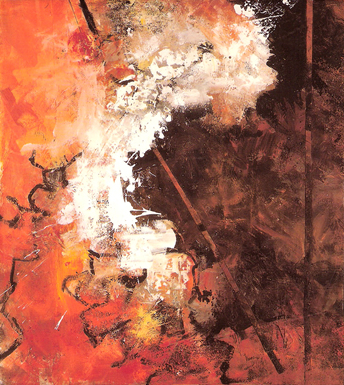
Capriccio 1974
was done after a plane flight during which I suddenly realized the imprint of Man is the straight line. Nature is primarily organic and flowing, but wherever you find Man, you find straight lines. Perhaps it's his way of trying to bring order to the seemingly unorganized natural phenomena, or perhaps it's his way of trying to understand the geometry of the Universe. At any rate, as you fly across the country, you can always spot “civilization” by the straight line.
We have even more recent views of our earth from our spacecraft... |
 |
 |
And then views of the moon, and even views ON the moon! |
This painting was done in response to seeing the first footsteps on the moon on TV.

Footsteps on the Moon
There are many other examples of microscopic photography
................... underwater photography ....... infrared photography
[ http://www.atsf.co.uk/ilight/photos/index.html ],
and more recently, of intriguing abstract patterns from CT scans and MRI 's.
And every day, it seems, we hear of some new engineering [and tech] marvel bringing new means of seeing to our attention. All these influence and intrigue the abstract artist.
Of course, ALL art is really abstraction—the difference is only the degree. And in general, most artists progress from more naturalistic to the more abstract as their visual language improves and they learn to express emotion.
If you look at Hofmann's early works [on this his website http://www.hanshofmann.net/art/art.html and on this http://www.artnet.com/artist/8387/hans-hofmann.html ]
you will notice that in the early works, he has more object references. But as he progresses, his focus changes from not so much object reference but to an expression of his feelings.
These examples:
http://www.nga.gov/cgi-bin/pinfo?Object=85613+0+none
http://www.nga.gov/cgi-bin/pinfo?Object=55693+0+none
show more the feeling of the sunset invading the whole land with its orange hues—or perhaps a Fall scene, rather than objects.
In his later works, he has gone a step further in his progress, no longer tied to the naturalistic representation of objects such as buildings, but he still uses the forms at times for structural purposes. He is still expressing the same orange glow of the sun, or again perhaps, an aerial view of a street, buildings and trees in their Fall dress. All of us, of course, have experienced an emotional response to the setting sun turning our whole world to orange, one of nature's ways of evoking an emotional response with color. And those of us who have lived in the North, the glorious colors of Fall [evoke such a response]. Here is one of my paintings which could express either or both of the two natural phenomena—depending upon the experience of the viewer. One who has never seen the orange hills of a New England Fall would probably only see the sunset.
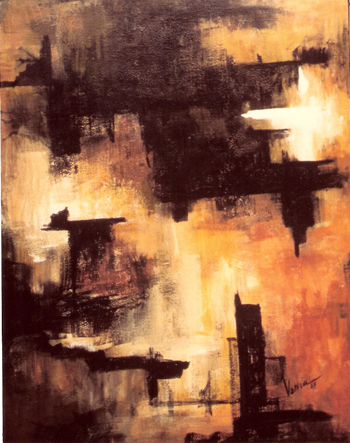
As perhaps you have become increasingly aware, all of these more abstract works have begun focusing on the space around us—what artists have called “negative space”—the ether, air, surrounding all the objects in our world. Hofmann felt this negative space every bit as important as the objects in that space, and perhaps even more so. Here in my painting this concept is expressed by the “mist” and the movement in and through it being certainly as important as the harbor scene—if not more important.
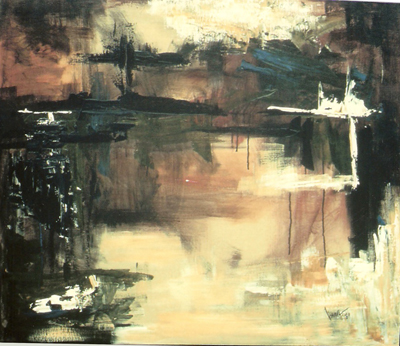
Water's Edge 1968
And another where the forces and strength I've felt in sunlight and wind movement through space are the main focus.
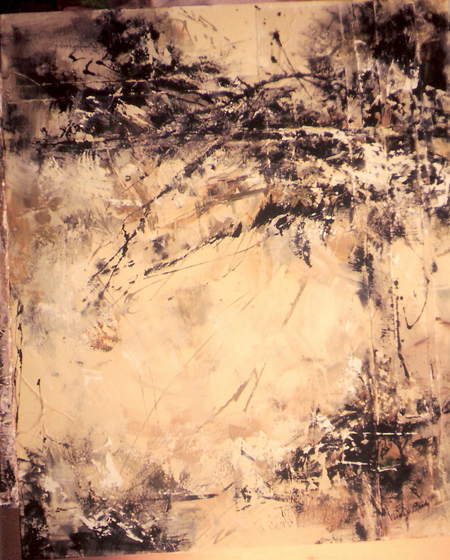
Sunlit Waters 1976
This concern with negative space is very much a 20 th Century concept. Einstein once said that the way he differed from Newton was that Newton studied the objects in the Universe, while he studied the milieu as well. And, of course, if our scientists and engineers had not understood the forces in space, we'd never have gotten off the ground, much less a spacecraft to the moon and beyond! And the latest concern of all—ecology—smog, pollution—another case in which the space around us has become increasingly important and necessary to focus on.
Artists who are interested in reflecting what is important to the time in which they live, find it necessary to use a different means from previous centuries. So let us move on to the medium of Expression—paint applied to canvas.
Expression-- paint applied to canvas
One of the reasons this focus was so strong was that until the 19 th Century artists had to do the reporting: battle scenes, coronations, important events, portraits. The invention of the camera and modern painting methods were what freed the 20 th Century artists to explore different aspects of the world around them. At first many artists hated the camera—it had taken their job away! It took some a long time to realize that they were freed and even aided by this new-fangled contraption. Nevertheless, this avenue has continued especially in such areas as tramp d'oeil, Pop art and the Surrealism of today actually making use of the camera. And of course photography itself is now considered a legitimate form of Art.
The first artists to actually make use of the new freedom were the Impressionists http://en.wikipedia.org/wiki/Impressionism who broke with the tradition of perspective with their fascination with light and their exploration of the phenomena at varying times of the day. Their line of endeavor has developed along such lines as the exploration of optics by the Op artists and the exploration of artificial light as an artistic expression.
Following the Impressionists were the cubists
http://en.wikipedia.org/wiki/Cubism
with their break-up of form and attempts to put down an “in the round” effect of the way we actually see. Rarely do we experience a single view of anything. Either it moves, we move, or even just our eyes shift so that we get several views of whatever we are looking at. They were moving towards the expression of movement, of life in that sense—especially Duchamp with his nude descending the staircase. http://en.wikipedia.org/wiki/Nude_Descending_a_Staircase
This area of concentration has led to explorations such as Vassarily, Igam, kinetic art and onto holograms.
When Hofmann came along, he wanted to express not only the light of the Impressionists and the movement of the Cubists, but also the movement of the unseen forces he felt in the universe around him and even more important, his own emotional reactions to nature. His avenue of approach follows in the long line of artists involved with the expression of their inner emotions, beginning with Rembrandt; Van Gogh with his tortured visions, Soutine, de Kooning.
Hofmann's contribution to this tradition was the powerful abstract language he developed to visualize his emotions. His methods have carried on in artists like McNeil with his strong expressionistic works, Mitchell with her powerful abstractions, Frankenthaler with her stain techniques, and my own work with its lyric qualities. We do not try to imitate Hofmann but rather go on to develop our own visual language for putting ourselves into our painting.
Push/pull and Dynamic Equilibrium
The two major concepts set forth by Hofmann for this visual expressionism are push/pull and dynamic equilibrium. Hofmann felt “push/pull” better expressed the world around him and the forces in it—expansion, contraction, movement, life. As we all know, movement is a manifestation of life and without movement, there is no life. He felt that a painting must give the sensation of movement in order to really express life. By so doing, it becomes much truer to life than imitation by perspective and surface modeling. Push/pull creates movement both in and out of a canvas and also around and through it. The “in and out” movement is achieved with overlapping planes, and the “around” movement by color intervals. [Remember "The Pond" painting at the beginning of this lecture.]
Now let us move on to the “around and through” push pull. This is accomplished by what is called color intervals. I like to explain this concept in relation to music—to theme and variation. When you hear a theme played, then an intervening melody and then return to the theme, you remember having heard the theme a while ago, that an interval has elapsed and so you experience a sensation of time. Movement in painting is much the same...
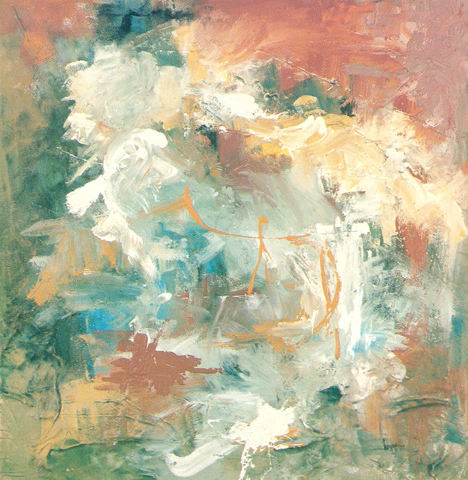
Four Elements
As your eyes move to a color interval, you intuitively realize that you have passed through space to arrive at the second and the third, and so the sensation of space and movement is conveyed.
I purposely chose Hofmann to first explain push/pull because my own use of it is considerably subtler and therefore sometimes less obvious. But his theories are nevertheless at work even though their use is often more complex.
There is also another way to convey the sensation of movement in a painting illustrated quite strongly in this work [above]. By leaving evidence of the actual movement of my hand, I evoke an intuitive response in you—you “feel” the motion I went through in applying the paint. This adds to your experience of the sensation of movement.
Hoffmann's “push/pull” creates movement both in and out of the canvas and also around and through it. The “in and out” movement is achieved with overlapping planes and the “around” movement by color intervals. Let me go on to explain with the Hofmann [below].
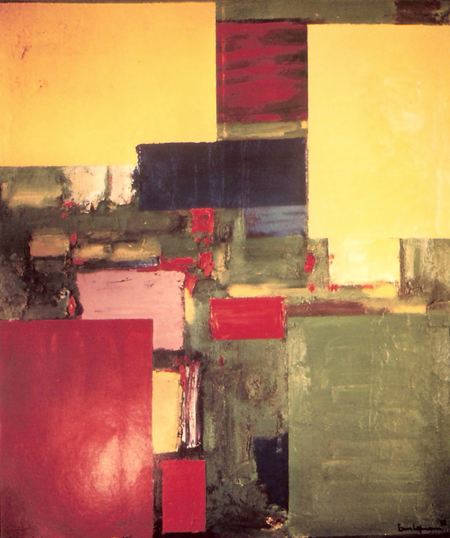
Let's begin with the “in and out” push/pull—the overlapping planes. If we start with this yellow in the upper left , it seems to advance towards us—partly because it's a light color and light colors always advance, but also because it is overlapping the red and also the more atmospheric green.
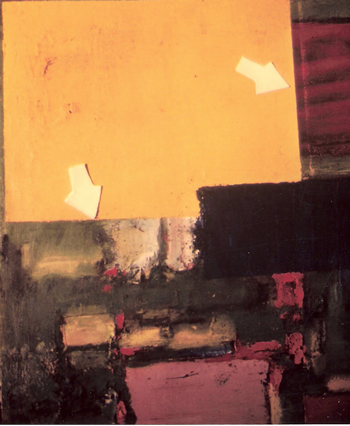 |
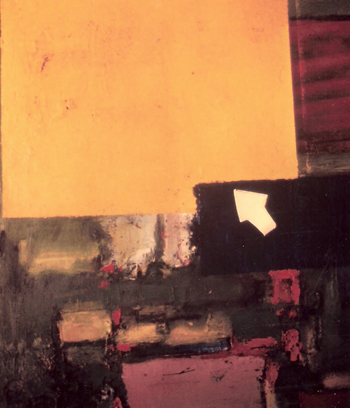 |
Figure 1 ................................................................................Figure 2.................................................................
These two are pushing the yellow ahead, and the yellow is pushing them back [figure 1]. But wait—move on to the lower right hand corner of the yellow plane [figure 2] here suddenly the advancing yellow is shoved back by the overlapping dark blue , even though blue is a more atmospheric color and would normally tend to recede. So here we have the push/pull—the yellow pulls ahead of the colors it overlaps, and is pushed back by the overlapping color. The blue, too, experiences the same treatment. It is pulled ahead of the first yellow until we move across to find it overlapped by this yellow and pulled back again [below figure 3]. Movement, counter-movement—the pulsation of objects in space. And the yellow here in the right seems to be the farthest ahead but kept from flying right out at us by being nailed to the picture plane (the side of the canvas). Anything attached to the picture plane is held right there. And so we have a five-step sensation of depth and space. [figure 4] In the lower left hand corner is another push/pull creating depth. The red is overlapping, and so on.
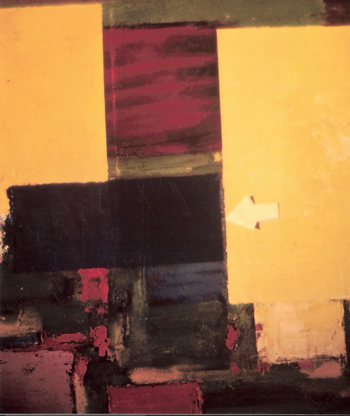 |
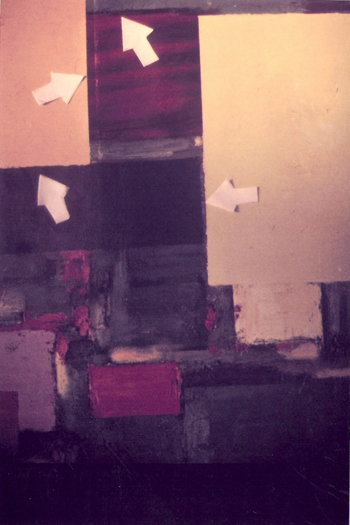 |
Now let's move on to the “around and through” push/pull. This is accomplished by what we call color intervals. I like to explain this concept in relation to music—to theme and variation. When you hear a theme played, then an intervening melody and then a return to the theme, you remember having heard the theme a while ago, that an interval of time has elapsed and so you experience a sensation of time. Movement in painting is much the same. When you enter this painting in the lower left, you came in contact with the strong red; as your eyes wanders, you came across the same red [at regular intervals], and as your eyes moves, you remember that first red, and intuitively realize that you have passed through space to arrive at the second and the third, and so on. And so the sensation of movement and space is conveyed. The yellows do the same, as do all the other colors. [see full painting at beginning of sequence].
I purposely chose Hofmann's first to explain push/pull because my own use of it is somewhat subtler and therefore sometimes less obvious. But his theories are, nevertheless, at work in all my work.

Four Elements
So let's begin with the red area in the lower left. It serves as a strong push force because it is obviously put right on the surface, but also because it overlaps the white underneath. The white overlaps the blue, which overlaps the gray. The gray overlaps the deep red. This red is also overlapping an even deeper blue, yet this blue and the surrounding grays are kept from becoming too atmospheric by the orange sweep which serves to pull the whole area back from infinity and not push it back from the surface at the same time. The strong surface red is kept from flying off the picture plane by the pull of the same red nailed to the top of the canvas and also the pull of these very deep reds way back in space. So here in this one area we have a 5 step push/pull back and forth in space. In any other area, you will find the same in and out movement throughout.
There is also another way to convey the sensation of movement in a painting illustrated quite strongly in this work. By leaving evidence of the actual movement of my hand, I evoke an intuitive response in you. You “feel” the motions I went through in applying the paint. The tubed on orange, the brush strokes put on with force and strong movement and then left untouched, the strokes of the palette knife applying the red, the splatter of the thrown white—all add to the sensation of movement.
In this [following] piece from my symphony series Mahler, we find the push/pull in and out of space by the overlapping of lines as well as planes. I will not belabor the point because perhaps by now you are finding the relationships yourself— the brown in the lower right and overlapping the black, the black the yellow, the yellow the ochre, on to a deeper yellow, and so forth throughout the painting.
And again we have the color interval movement around—browns, pinks, blacks, etc.
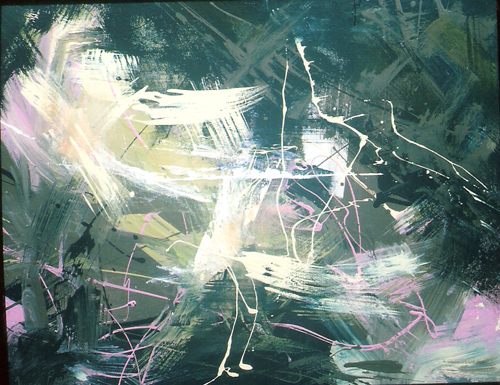
And, of course, the strong brushwork and the controlled throws are contributing much to the liveliness of the whole.
Here is a shot of the Symphony in its beginning stages showing the canvases ready to go.
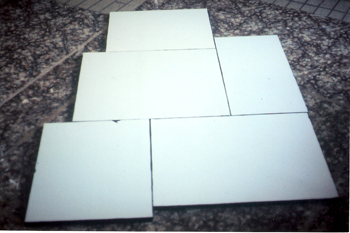
Another form of tension is introduced by placing each movement just far enough apart to create another push/pull. Each movement is striving to break free and stand alone, as indeed it was meant to do. For in the process of painting I took each part to my easel and worked it separately, just as in a musical symphony, each part must also be able to stand alone even though related to all the rest.
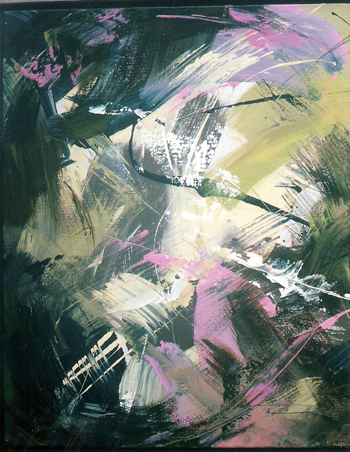 |
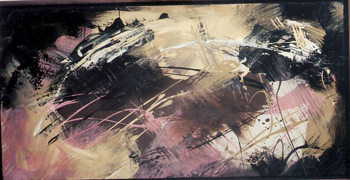 |
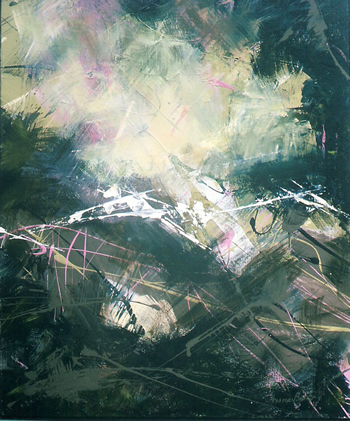 |
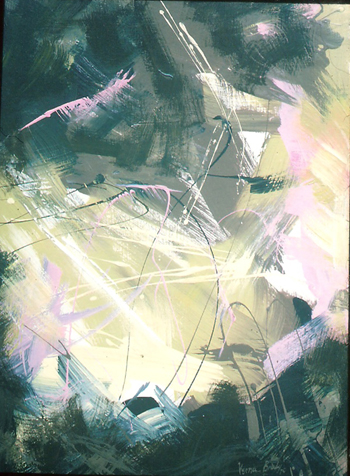 |
Yet this force is countered by their being placed close enough for the strong movement and color intervals to bring it back together. [See full suite photo at beginning of this sequence.] Placed too far apart, the movement and color pulling it together would weaken and each of the works would stand all alone. Place right next to each other, as originally begun, the pull of the color intervals and movement would far overshadow the push for independence, and thus diminish the dynamic tension of the piece.
As you may have guessed by now, Hofmann and his disciples feel color to be the strongest building block in a painting. This is why we reject aerial perspective as weakening and diluting our best means to a powerful statement. Light and shade are rejected because they express only reflected light. On the other hand, paint usually can create light from within, making the painting generate a light of its own, bringing a vibrating quality far more “real” than dilutions of surface color.
In Nature light produces color. We all know this. Without light there is darkness and no color. In Art, however, the paint itself must create the light, and the best way to accomplish this is to use the colors for their own individual qualities of light and dark, and combine them in expressive contrast, not by illumination or surface modeling, but by the quality of the paint itself. For instance, if I were to paint any one of these canvases completely black the feeling of darkness would not exist. Or if I were to paint one completely white, no light would exist either—brightness perhaps, but not light. It is the contrast between the darks and the lights which gives the sensation of light. In this series, for example, more darkness is felt in the painting in the lower right than in all the rest, because it is predominately dark, but with enough light to produce the sensation of overall darkness with an emitted light. The top painting is on the opposite end of the ratio with a predominance of light color, but again, with enough darks to create the sensation of light. They all are dramatic dark and light patterns because the paint is used to create the light, not shading.
All of these forces that I have been discussing—push/pull, movement, light—combine to create a state of dynamic equilibrium in a well-done work. The painting is in balance—not formally, nor statically, but in a living, breathing, dynamic way. Equilibrium, incidentally, is another of the contemporary concerns. Worry that by losing our ozone layer, using up our natural resources, polluting all of our water and air, we will lose our equilibrium in the Universe with disastrous results.

Circe
The way a painting achieves equilibrium is to treat it as a Universe of its own. To accomplish this, both Hofmann and McNeil taught their students to work all four sides of the canvas, turning by quarter turns and adjusting the balance of colors and movement with each turn, to create a tension throughout of movement and counter-movement.

Circe, quarter turn clockwise
For each time a brush stroke is put on the canvas, there must be a readjustment throughout.
 |
 |
Circe, half turn |
Circe 1/4 turn counter-cw |
It's the same sort of thing scientists talk about when they say that “for every action there is an equal and opposite reaction,” and what Pascal's hydraulic theory (the theory that makes your brakes work) is also all about—his discovery that pressure applied anywhere on an enclosed liquid is transmitted throughout.
But I like to use a balloon to explain the phenomena. A balloon with no air in it has no tension. It's a pretty floppy thing. But the minute it is inflated, there is a surface tension everywhere pushing out from inside. Now what happens if you push your finger in on one side? You get a bulge out the other side, right? And the balance of tension won't return until you remove your finger.
And so with painting, a strong push somewhere will throw it off balance and require compensation either by a pull somewhere else to bring back the balance, or by the removal of the strong push. With either solution, the painting is brought back into a dynamic balance of tension resulting in another expression of life force.
We have discussed nature and the medium, and now are at the point of discussing “empathy,” that faculty which changes a canvas into a work of art.
Empathy—a work of art

Capriccio
Empathy is one of those difficult terms to explain. McNeil used the word “interiorize” and urged us to dig deep within ourselves to the source of all emotions—those emotions not easily describable in words, but better understood by experience. This deep inner space is what Jung referred to in his “tapping of the collective unconscious.” He felt that deep within each one of us lies the heritage of the whole human race giving us a storehouse of mutually felt experiences—experiences too deep to be easily tapped and too subjective to be easily communicated. Of course, even the deeply subjective emotions of which we are conscious are extremely difficult to communicate except through mutual experience. Who can explain love, or joy or any of our deeply felt emotions?.!
Yet the desire to communicate is very strong within us all. It's why a poet and composer writes and why an artist paints—to communicate with his fellow man some of his deepest thoughts and emotions.
And it is this communication which lifts the work of Art into the realm of spirituality, for part of the communication is the creative experience itself, which is a true religious experience. Not an iconic illustration, nor a parable, but a true religious experience.
Our concept of God, in whatever religion and whatever name, is that of a Superior Being who created the Universe and us from nothing, from cosmic dust. We find this hard to understand and are constantly seeking the answers to “How?” and “Why?” Yet when I take my two “nothings”—a piece of canvas and some blobs of paint, and create with them something new, something worthwhile, something never seen before, I'm doing the same sort of thing that God does, and so feel very close to God, and experience the deep joy and satisfaction of creation. I don't, of course, really understand the “How” of God's ways, but I certainly feel something of the “Why” . . . and experience a oneness with my Maker and the Universe. And when I translate this experience into my medium and thus into physical reality, I am doing something quite the opposite of illusion. I'm putting me down on that canvas—my whole being—my thoughts, my feelings, my soul. I believe the real worth of art, really why it has been so important down through the ages, is that one of man's strongest drives is the desire to understand and feel close to God, and figure out how and why God made him. The artist wants a deeper communion with God, and with the viewer.
How do I know when a painting is done? In the beginning stages of a painting, the two forces within me that I am working with—my conscious mind organizing the colors and composition, and my subconscious intuition expressing my emotions—seem to be going their separate ways, back and forth, from form to emotion to form to emotion. But because I am receptive to the painting itself as well as to my own inner psyche, somewhere in the course of the painting those two forces come together, and from then on I know where the painting is going, and when it is done.
In “Sounding,” [below] as I was taking slides to show the progression of a painting for my lecture, when I got to that point, the personal involvement at the time was too intense to be able to stop and take slides. I felt charged, almost—like all my nerve endings were raw with sensitivity and I painted intensely. And at the moment of birth, I felt much at one with my Maker and the Universe and experienced a surge of joy and fulfillment which is, after all, what we are all searching for in our own
Search for the Real.
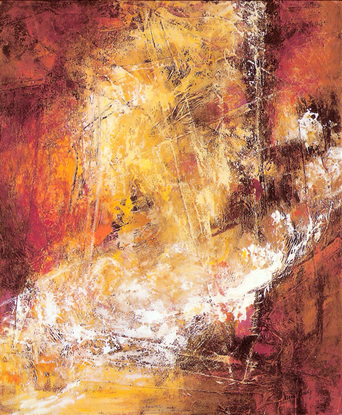
Sounding
[This lecture was edited from Verna's lecture notes and slides by Caryn Brady, Verna's daughter. All materials on this site are subject to copyright. Please contact us for permission to use any of these materials.]
